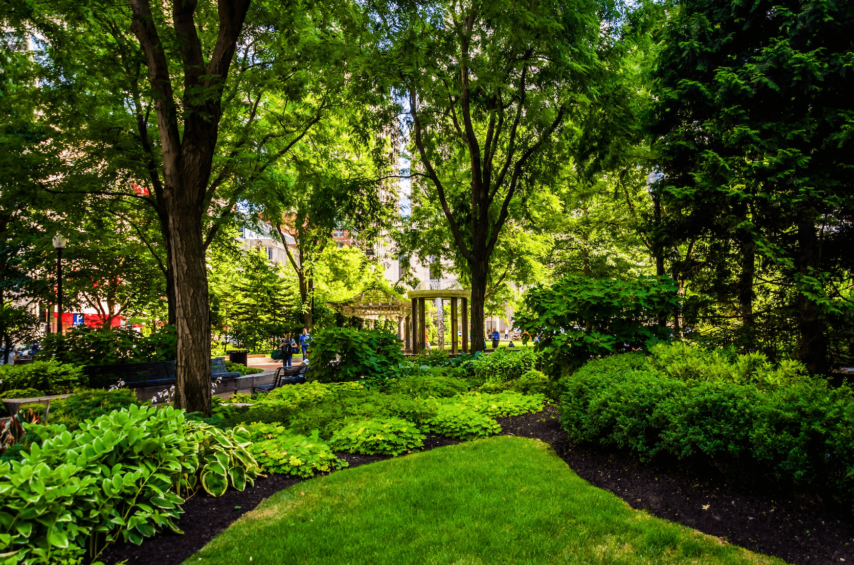
New England Landscaping Ideas: Beautiful and Low Maintenance
Creating an inviting outdoor space that is both beautiful and manageable is an essential aspect of home ownership in New England. The quest for New England landscaping ideas that marry aesthetic appeal with low maintenance is more than just a trend; it’s a practical approach to enhancing one’s living environment. The volatile New England climate presents unique challenges, making it crucial to select plants and design gardens that thrive across the region’s varied seasons. This endeavor not only elevates the beauty of residential spaces but also significantly enhances property value.
This article delves into the cornerstone elements of crafting a landscape in New England that is both visually stunning and easy to care for. By assessing your landscape needs, choosing the right plants suited to the New England climate, incorporating hardscaping elements, and designing for function and aesthetics, homeowners can achieve an outdoor space that complements their lifestyle. Further, the article will provide guidance on maintaining your landscape to ensure its beauty endures through the seasons. Through these insights, readers will be equipped with the knowledge to create their own low-maintenance garden oasis.
Assessing Your Landscape Needs
Understanding Your Current and Future Yard Use
- Current Utilization: It is essential for homeowners to consider how their yard is currently used. This includes assessing areas frequently used by family members and pets, such as play areas for children or paths commonly traversed.
- Future Plans: Homeowners should also think about potential changes or enhancements they wish to make. This might involve converting existing spaces to serve different functions or adding new features like patios or play areas.
Evaluating Environmental Conditions
- Soil and Climate: Knowing the type of soil (sandy, clay, etc.) and the microclimate conditions of your property is crucial. Homeowners can get a soil test to determine the soil’s properties and suitability for certain plants.
- Sunlight and Wind: Assess the typical wind conditions and sunlight exposure in your yard. These factors will influence the choice of plants and their placement, ensuring they thrive in existing conditions.
Planning for Maintenance and Budget
- Maintenance Style: Decide whether you prefer a hands-on approach to yard maintenance or a more hands-off style. This choice will affect the type of landscaping elements and plants you select.
- Budget Considerations: Homeowners must consider both initial installation costs and ongoing maintenance expenses. These financial considerations are vital in planning a sustainable and manageable landscape.
By carefully assessing these aspects, homeowners can create a functional and aesthetically pleasing outdoor space that aligns with their lifestyle and environmental conditions.
Choosing the Right Plants for New England Climate
Selecting Native Plants
- Adaptation to Local Climate: Native plants are inherently adapted to the New England climate, which includes cold, snowy winters and warm, humid summers. These plants have evolved to thrive in local soil and weather conditions, reducing the need for extensive maintenance.
- Support for Local Wildlife: Indigenous plants play a crucial role in supporting local ecosystems. They provide necessary shelter and food for native wildlife and are essential for attracting and sustaining pollinators like bees and butterflies.
Opting for Low-Maintenance Plants
- Drought Resistance: Choosing plants that are tolerant to varying moisture levels can significantly reduce the need for watering. For instance, species such as Sedum ‘Autumn Joy’ and the robust Liatris spicata are known for their drought tolerance.
- Minimal Care Requirements: Perennials like the Eastern Bluestar and Coral Bells require minimal upkeep beyond occasional pruning and dividing. These plants offer seasonal colors and textures, enhancing the garden’s aesthetic with little effort.
Using Evergreens and Perennials
- Year-Round Interest: Evergreens such as pine trees and holly bushes provide color and structure throughout the year. They are crucial for creating a backbone for the landscape in winter months when other plants have died back.
- Perennial Favorites: Plants like the Hardy Geranium and Astilbe bring recurring joy as they bloom each year, filling the garden with color and life. These perennials adapt well to the New England climate, coming back stronger each season.
Incorporating Hardscaping Elements
Patios and Walkways
Incorporating hardscaping elements such as patios and walkways into a New England landscape enhances both aesthetics and functionality. Using materials like Swenson Granite Work’s Woodbury Gray granite not only provides durability but also adds a distinct charm to the property. The use of granite in the pool patio, front walkway, and steps ensures a cohesive look that withstands the region’s harsh weather conditions. Additionally, creative designs such as dark-toned aggregate paths bordered with granite slabs introduce an artistic element that draws the eye and complements the surrounding plantings.
Using Gravel and Stones
Gravel and stones are versatile materials that serve various functional and decorative purposes in landscaping. For instance, Woodbury Gray granite pavers with beach pebble joints create attractive and durable walkways leading to different areas like the pool terrace. These materials not only enhance the visual appeal but also improve drainage, limit weed growth, and reduce maintenance needs. Incorporating gravel and stones in the design can also help in achieving a modern and cohesive aesthetic that resonates with the clean lines of contemporary architecture.
Mulch and Ground Covers
Mulch plays a crucial role in maintaining a low-maintenance landscape. It suppresses weeds, retains moisture, and adds nutrients to the soil, enhancing plant health and garden aesthetics. Organic mulches like shredded leaves or bark contribute beneficial nutrients, while inorganic options such as gravel or landscape fabric effectively block weed growth. Additionally, integrating ground covers like periwinkle or hardy geraniums can reduce soil erosion and create a lush, vibrant underlay that requires minimal upkeep. These ground covers not only beautify the space but also provide a habitat for local wildlife, enriching the biodiversity of the garden.
Designing for Function and Aesthetics
Creating Relaxing Spaces
In designing landscapes that serve both functional and aesthetic purposes, homeowners should consider integrating elements that promote relaxation and tranquility. Utilizing natural stone, such as granite steps and patio pavers, not only adds a timeless beauty but also ensures durability. For a serene retreat, incorporating a water feature can enhance the soothing ambiance, with the sound of water providing a calm backdrop to outdoor living spaces.
Implementing Sustainable Practices
Sustainable landscaping is pivotal in promoting environmental health and reducing carbon footprints. Converting underutilized lawns into pollinator-friendly habitats can significantly decrease maintenance costs while improving air quality and supporting local wildlife. Additionally, opting for battery-powered landscape equipment can reduce greenhouse gas emissions and lower maintenance costs, making it a practical choice for eco-conscious homeowners.
Balancing Open Spaces and Plantings
Achieving a harmonious balance between hardscaped areas and plantings is crucial for a well-rounded landscape. Designing with ecological principles in mind, such as using native plants and organic landscaping practices, enhances the garden’s sustainability and beauty. Grouping plants by their water needs and incorporating drought-tolerant species can conserve water and reduce upkeep. Strategically placed trees and shrubs can add structure to the landscape while providing year-round interest and wildlife benefits.
Maintaining Your Landscape
Seasonal Tasks
- Spring Preparation: Begin by clearing out winter debris from garden beds to prevent pests and diseases. It’s also the ideal time to prune most shrubs and trees, especially removing dead or damaged branches. For spring bloomers like forsythia, prune only after flowering to preserve this year’s blooms.
- Fall Activities: As cooler temperatures arrive, increase mowing frequency and use mulching settings on mowers for fallen leaves. Prepare for winter by deep watering ornamental trees and performing a thorough cleanup of leaves to prevent smothering the grass.
Watering and Irrigation Tips
- Efficient Watering Techniques: Apply a layer of organic mulch around plants to retain soil moisture and regulate temperature. Establish a watering schedule that encourages deep root growth by watering deeply but less frequently.
- Drought Management: During dry spells, allow grass to go dormant to conserve water. For non-dormant periods, water lawns early in the morning to minimize evaporation and ensure deep soil penetration.
Pruning and Plant Care
- General Pruning Guidelines: Prune flowering shrubs based on their blooming cycles—after blooming for spring bloomers and during dormancy for others. Always use clean, sharp tools and avoid removing more than one-third of a shrub’s mass annually to maintain health and vigor.
- Specialized Care for Different Plants: Different plants require varying pruning approaches. For instance, hydrangeas and roses might need pruning in late winter or early spring to promote blooming, while ornamental grasses can be cut back in early spring to prepare for new growth.
Conclusion
Throughout this exploration of New England landscaping, we’ve journeyed through the essentials of creating aesthetically pleasing yet low-maintenance outdoor spaces, accommodating the region’s diverse climate. Drawing from the wellspring of native plant selection to the inclusion of durable hardscaping, these guidelines offer a pathway to crafting serene landscapes that resonate with both beauty and resilience. The highlighted importance of aligning design with the environment’s demands, alongside practical maintenance advice, underpins the dual quest for elegance and simplicity in our outdoor sanctuaries. As homeowners in New England strive to create these perfect retreats, embracing the guidance on sustainable practices and seasonal care becomes a testament to a commitment not just to personal satisfaction but also to environmental stewardship. Amid these endeavors, safeguarding one’s property with reliable insurance becomes indispensable. For those seeking to protect these carefully curated landscapes and their underlying assets, reaching out to Safety Northeast Insurance for a competitive quote today ensures peace of mind, making it an essential step in the journey to manifesting one’s landscaping dreams.

 Previous Post
Previous Post Next Post
Next Post